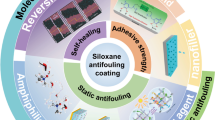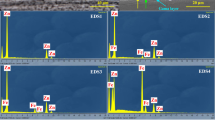Abstract
The anticorrosion and barrier properties of poly(dimethylsiloxane) (PDMS)–ZnO nanocoating transition from superhydrophobic to hydrophobic state have been evaluated. The main objective was to appraise the durability performance of anticorrosion and barrier properties of the pristine superhydrophobic coating and its hydrophobic state after long-term exposure to marine water. Thus, water wettability, surface features, and corrosion resistance, as well as barrier performance of the 1H, 1H, 2H, 2H-perfluorodecyltrichlorosilane-modified PDMS–ZnO coating were evaluated after 15 cycles (1 h to 60 days) of immersion in 3.5 wt.% NaCl solution. The evaluations were made by use of surface analytical, physicochemical, and electrochemical techniques. The results show that the coating transformed from superhydrophobic state (after 1 h) to hydrophobic state (after 60 days). The transition was due to effect of corrosiveness of the salty water and disappearance of the surface air layer with consequent reduction in the surface roughness and increase in the porosity of the coating. Correspondingly, the value of the impedance modulus decreased from 4.257 × 109 Ω cm2 (after 1 h) to 7.175 × 108 Ω cm2 (after 60 days). The trend of coating film (Rcf) and charge transfer (Rct) resistances with immersion time was found to be somewhat stable after 40-day immersion time. The observed high values of impedance modulus (|Z|f=0.01 Hz), Rcf and Rct after 60 days of immersion clearly demonstrate that the anticorrosion property and barrier performance of the transformed hydrophobic PDMS–ZnO coating were good.






Similar content being viewed by others
References
Xin, B, Hao, J, “Superhydrophobic Self-Assembled Monolayers of Long-Chain Fluorinated Imidazolium Ionic Liquids.” RSC Adv., 2 5141–5146 (2012)
Steele, A, Bayer, I, Moran, S, Cannon, A, King, WP, Loth, E, “Conformal ZnO Nanocomposite Coatings on Micro-patterned Surfaces for Superhydrophobicity.” Thin Solid Films, 518 5426–5431 (2010)
Basu, BJ, Dinesh Kumar, V, Fabrication of Superhydrophobic Nanocomposite Coatings Using Polytetrafluoroethylene and Silica Nanoparticles. ISRN Nanotechnol. ArticleID 803910 (2011).
Chakradhara, RPS, Dinesh Kumara, V, Rao, JL, Basu, BJ, “Fabrication of Superhydrophobic Surfaces Based on ZnO–PDMS Nanocomposite Coatings and Study of Its Wetting Behavior.” Appl. Surface Sci., 257 8569–8575 (2011)
Privet, BJ, Young, J, Hong, SA, Lee, J, Han, J, Shin, JH, Schoenfisch, MH, “Antibacterial Fluorinated Silica Colloid Superhydrophobic Surfaces.” Langmuir, 27 (15) 9597–9601 (2011)
Neelakantan, NK, Weisensee, PB, Overcash, JW, Torrealba, EJ, King, WP, Suslick, KS, “Spray-on Omniphobic ZnO Coatings.” RSC Adv., 5 69243–69250 (2015)
Arukalam, IO, Oguzie, EE, Li, Y, “Nanostructured Superhydrophobic Polysiloxane Coating for High Barrier and Anticorrosion Applications in Marine Environment.” J. Colloid Interface Sci., 512 674–685 (2018)
Wang, G, Zeng, Z, Wang, H, Zhang, L, Sun, X, He, Y, Li, L, Wu, X, Ren, T, Xue, Q, “Low Drag Porous Ship with Superhydrophobic and Superoleophilic Surface for Oil Spills Cleanup.” ACS Appl. Mater. Interfaces, 7 (47) 26184–26194 (2015)
Wang, G, Zeng, Z, Chen, J, Xu, M, Hu, J, Liu, S, Ren, T, Xue, Q, “Ultra Low Water Adhesive Metal Surface for Enhanced Corrosion Protection.” RSC Adv., 6 40641–40649 (2016)
Ammar, Sh, Ramesh, K, Vengadaesvaran, B, Ramesh, S, Arof, AK, “Amelioration of Anticorrosion and Hydrophobic Properties of Epoxy/PDMS Composite Coatings Containing Nano ZnO Particles.” Progr. Org. Coat., 92 54–65 (2016)
Heinonen, S, Nikkanen, JP, Laakso, J, Raulio, M, Priha, O, Levanen, E, “Bacterial Growth on a Superhydrophobic Surface Containing Silver Nanoparticles.” Mater. Sci. Eng., 47 012064 (2013)
You, I, Seo, YC, Lee, H, “Material-Independent Fabrication of Superhydrophobic Surfaces by Mussel-Inspired Polydopamine.” RSC Adv., 4 10330–10333 (2014)
Qian, H, Xu, D, Du, C, Zhang, D, Li, X, Huang, L, Deng, L, Tu, Y, Mol, JMC, Terryn, HA, “Dual-Action Smart Coatings with a Self-Healing Superhydrophobic Surface and Anti-corrosion Properties.” J. Mater. Chem. A, 5 2355–2364 (2017)
Qian, H, Li, M, Li, Z, Lou, Y, Huang, L, Zhang, D, Xu, D, Du, C, Lu, L, Gao, J, “Mussel-Inspired Superhydrophobic Surfaces with Enhanced Corrosion Resistance and Dual-Action Antibacterial Properties.” Mater. Sci. Eng. C, 80 566–577 (2017)
Mahalakshmi, PV, Vanithakumari, SC, Gopal, J, Kamachi Mudali, U, Raj, B, “Enhancing Corrosion and Biofouling Resistance Through Superhydrophobic Surface Modification.” Curr. Sci., 101 (10) 1328–1336 (2011)
Zhang, D, Wang, L, Qian, H, Li, X, “Superhydrophobic Surfaces for Corrosion Protection: A Review of Recent Progresses and Future Directions.” J. Coat. Technol. Res., 13 (1) 11–29 (2016)
Ault, J, Lockwood, P, Cloutier, R, Kinee, D, “Use of Polysiloxane Coatings for Topside Applications on US Navy Ships.” Naval Eng. J., 128 (1) 65–70 (2016)
Basu, BJ, Bharathidasan, T, Anandan, C, “Superhydrophobic Oleophobic PDMS-Silica Nanocomposite Coating.” Surf. Innov., 1 (S11) 40–51 (2013)
Yuan, Z, Bin, J, Wang, X, Wang, M, Huang, J, Peng, C, Xing, S, Xiao, J, Zeng, J, Xiao, X, Fu, X, “Preparation of a Polydimethylsiloxane (PDMS)/CaCO3 Based Superhydrophobic Coating.” Surf. Coat. Technol., 254 97–103 (2014)
Jerschow, P, “Silicone Elastomers.” Rapra Rev. Rep., 12 (5) 171 (2001)
Manca, M, Cannavale, A, De Marco, L, Aricò, AS, Cingolani, R, Gigli, G, “Durable Superhydrophobic and Antireflective Surfaces by Trimethylsilanized Silica Nanoparticles-Based Sol–Gel Processing.” Langmuir, 25 (11) 6357–6362 (2009)
Zhang, D, Wang, L, Qian, H, Li, X, “Superhydrophobic Surfaces for Corrosion Protection: A Review of Recent Progresses and Future Directions.” J. Coat. Technol. Res., 13 (1) 11–29 (2016)
Zhang, J, Pu, G, Severtson, SJ, “Fabrication of Zinc Oxide/Polydimethylsiloxane Composite Surfaces Demonstrating Oil-Fouling-Resistant Superhydrophobicity.” ACS Appl. Mater. Interfaces, 2 (10) 2880–2883 (2010)
Arukalam, IO, Meng, MJ, Xiao, HG, Ma, YT, Li, Y, “Effect of Perfluorodecyltrichlorosilane on the Surface Properties and Anti-corrosion Behavior of Poly(dimethylsiloxane)–ZnO Coatings.” Appl. Surf. Sci., 433 1113–1127 (2018)
Su, X, Li, H, Lai, X, Zhang, L, Liang, T, Feng, Y, Zeng, X, “Polydimethylsiloxane-Based Superhydrophobic Surfaces on Steel Substrate: Fabrication, Reversibly Extreme Wettability and Oil-Water Separation.” ACS Appl. Mater. Interfaces, 9 (3) 3131–3141 (2017)
Zhang, ZP, Song, XF, Cui, LY, Qi, YH, “Synthesis of Polydimethylsiloxane-Modified Polyurethane and the Structure and Properties of Its Antifouling Coatings.” Coatings, 8 157 (2018)
Fini, EH, Al-Qadi, IL, Abu-Lebdeh, T, Masson, JF, “Use of Surface Energy to evaluate Adhesion of Bituminous Crack Sealants to Aggregates.” Am. J. Eng. Appl. Sci., 4 (2) 244–251 (2011)
Papadopoulos, P, Mammen, L, Deng, X, Vollmer, D, Butt, HJ, “How Superhydrophobicity Breaks Down.” PNAS, 110 (9) 3254–3258 (2013)
Yao, X, Chen, Q, Xu, L, Li, Q, Song, Y, Gao, X, Quéré, D, Jiang, L, “Bioinspired Ribbed Nanoneedles with Robust Superhydrophobicity.” Adv. Funct. Mater., 20 (4) 656–662 (2010)
Bormashenko, E, Pogreb, R, Whyman, G, Erlich, M, “Cassie–Wenzel Wetting Transition in Vibrating Drops Deposited on Rough Surfaces: Is the Dynamic Cassie–Wenzel Wetting Transition a 2D or 1D Affair?” Langmuir, 23 (12) 6501–6503 (2007)
Bartolo, D, Bouamrirene, F, Verneuil, É, Buguin, A, Silberzan, P, Moulinet, S, “Bouncing or Sticky Droplets: Impalement Transitions on Superhydrophobic Micropatterned Surfaces.” Europhys. Lett., 74 (2) 299–305 (2006)
Cassie, ABD, Baxter, S, “Wettability of Porous Surfaces.” Trans. Faraday Soc., 40 546–551 (1944)
Wenzel, RN, “Resistance of Solid Surfaces to Wetting By Water.” Ind. Eng. Chem., 28 988–994 (1936)
Nakade, M, Ogawa, M, “Synthesis and Characterization of Zinc Oxide Fine Particles Coated with Titania/PDMS Hybrid.” J. Mater. Sci., 42 4254–4259 (2007)
Wassilkowska, A, Czaplicka-Kotas, A, Zielina, M, Bielski, A, “An Analysis of the Elemental Composition of Micro-samples Using EDS Technique.” Tech. Trans. Chem., 1 133–148 (2014)
Arukalam, IO, Oguzie, EE, Li, Y, “Fabrication of FDTS-Modified PDMS–ZnO Nanocomposite Hydrophobic Coating with Anti-fouling Capability for Corrosion Protection of Q235 Steel.” J. Colloid Interface Sci., 484 220–228 (2016)
Latthe, SS, Imai, H, Ganesan, V, Rao, AV, “Superhydrophobic Silica Films by Sol–Gel Co-precursor Method.” Appl. Surf. Sci., 256 217–222 (2009)
Djaja, NF, Montja, DA, Saleh, R, “The Effect of Co Incorporation into ZnO Nanoparticles.” Adv. Mater. Phys. Chem., 3 33–41 (2013)
Birbilis, N, Cavanaugh, MK, Sudholz, AD, Zhu, SM, Easton, MA, Gibson, MA, “A Combined Neural Network and Mechanistic Approach for the Prediction of Corrosion Rate and Yield Strength of Magnesium-Rare Earth Alloys.” Corros. Sci., 53 168–176 (2011)
Xu, Y, Ran, J, Chen, H, “Kohonen Neural Network Classification for Failure Process of Metallic Organic Coating in Corrosion Environment.” Metals, 7 147 (2017). https://doi.org/10.3390/met7040147
Acknowledgments
This research work was supported by the Chinese Academy of Sciences–President’s International Fellowship Initiative for Postdoctoral Research (Grant No. 2015PT005) and National Natural Science Foundation of China (Grant No. 51650110506). The authors are profoundly grateful.
Author information
Authors and Affiliations
Contributions
IOA designed and conducted the experiments as well as prepared the manuscript and YL finalized the manuscript. Both authors read and approved the final manuscript.
Corresponding author
Ethics declarations
Conflict of interest
The authors hereby declare there is no competing interest regarding the publication of this article.
Rights and permissions
About this article
Cite this article
Arukalam, I.O., Li, Y. Anticorrosion and barrier properties appraisal of poly(dimethylsiloxane)–ZnO nanocoating transition from superhydrophobic to hydrophobic state. J Coat Technol Res 16, 1077–1088 (2019). https://doi.org/10.1007/s11998-018-00182-2
Published:
Issue Date:
DOI: https://doi.org/10.1007/s11998-018-00182-2




